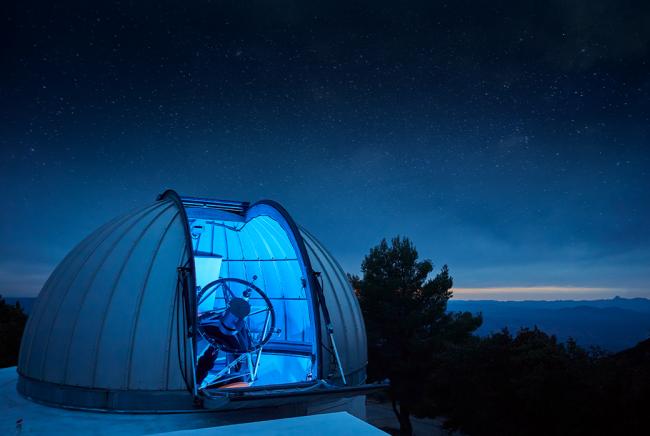Fred Lawrence Whipple Observatory - Mt. Hopkins, AZ
The Fred Lawrence Whipple Observatory (FLWO) is the largest satellite facility of the Smithsonian Astrophysical Observatory (SAO), part of the Center for Astrophysics | Harvard & Smithsonian. Located on Mt. Hopkins in southern Arizona, this remote site is home to a number of telescopes, including the 6.5 meter MMT Observatory. The observatory also includes the Very Energetic Radiation Imaging Telescope Array System (VERITAS) gamma-ray observatory, telescope arrays designed to find Earth-like exoplanets, and a number of other telescopes used for a wide range of astronomical observations.

The 1.2M Telescope at the Fred Lawrence Whipple Observatory in Arizona.
The Telescopes and Science
From its establishment in 1966 as the Smithsonian Mount Hopkins Observatory, FLWO has hosted a world-class suite of telescopes designed for a wide variety of purposes.
-
The largest visible-light telescope at FLWO is the MMT Observatory, which has a primary mirror 6.5 meters (21 feet) in diameter. Jointly operated by the Smithsonian and the University of Arizona, the MMT is located at the summit of Mt. Hopkins. The MMT was originally designed as the Multiple Mirror Telescope in 1979, consisting of six individual mirrors working together. With improved mirror technology, the smaller mirrors were replaced by the current large mirror in 2000, though the observatory kept the name “MMT”. In 2002, the observatory implemented “adaptive optics”, which uses a secondary mirror. The shape of this mirror can be changed to correct for distortions in Earth’s atmosphere, providing the sharpest images in astronomy. The MMT also includes spectroscopic instruments to identify atomic emission and other observations where precise light wavelength measurements are important.
-
CfA’s gamma-ray observatory VERITAS is located at the base of Mt. Hopkins, and consists of an array of four 12-meter telescopes. Earth’s atmosphere blocks gamma rays from reaching the ground, but in the process, the high-energy light creates a flash of blue light known as Cherenkov radiation. The VERITAS telescopes work together to observe the blue light, characterizing the sources of some of the highest energy light known: supermassive black holes and other extreme environments in the universe.
-
In addition to the MMT, the FLWO has two smaller general-purpose visible-light telescopes: the FLWO 1.2-meter imaging optical telescope and the 1.5-meter Tillinghast optical spectroscopic telescope. These telescopes are used in observing objects in the Solar System, as well as a wide variety of astronomical observations in the Milky Way and beyond.
-
FLWO is host to two Smithsonian computer-controlled automatic observatories — also known as robotic observatories — designed to look for potentially habitable planets: the MINiature Exoplanet Radial Velocity Array (MINERVA) and the MEarth Project. MINERVA consists of four 70-cm optical telescopes, which look for the large rocky planets known as super-Earths in orbit around Sun-like stars. The MEarth array of eight 40-cm optical telescopes is designed to find Earth-like worlds orbiting the small red stars called “M dwarfs”, which is the source of the “M” in the name.
-
The HATNet (Hungarian-made Automated Telescope Network) is an array of five robotic optical telescopes, currently operated by Princeton University. Along with two other telescopes located on Mauna Kea in Hawaii, these five instruments are designed to detect transits: the brief reduction in a star’s light when an orbiting exoplanet passes in front of it. To date, astronomers have used HAT to detect over 60 exoplanets.
-
The FLWO is also host to The Tierras Observatory, an upcoming fully-automated photometer capable of measuring the transit of Earth-sized planets orbiting M Dwarf stars with hitherto unachievable precision from the ground. Tierras will repurpose the dormant 1.3m telescope, which hosted the 2MASS (North) infrared camera over a decade ago.
Fred Lawrence Whipple and Mount Hopkins
Fred Lawrence Whipple (1906-2004) was an American astronomer who spent most of his professional career at Harvard University, where he discovered or co-discovered multiple asteroids and comets. In a series of influential papers published in the 1950s, he also developed the “dirty snowball” model of comets, which explains the dark color of a comet’s surface. Whipple served as director of the Smithsonian Astrophysical Observatory (SAO) from 1955 until 1973. During his tenure, SAO developed the Mount Hopkins Observatory, which was renamed for Whipple in 1981.
Mount Hopkins is a 2600-meter (8600 foot) tall mountain in the Santa Rita Mountains of southern Arizona, very close to the border with Mexico. The mountain is sufficiently far from Tuscon to be relatively unaffected by the city’s lights. Additionally, as a desert mountain, the weather is dry and clear much of the year, providing good observational conditions.

Dr. Gareth Hughes, VERITAS Deputy Operations Manager (left) and Dr. Michael Daniel, VERITAS Operations Manager (right) operate the VERITAS gamma ray observatory at the Fred Lawrence Whipple Observatory in Arizona.